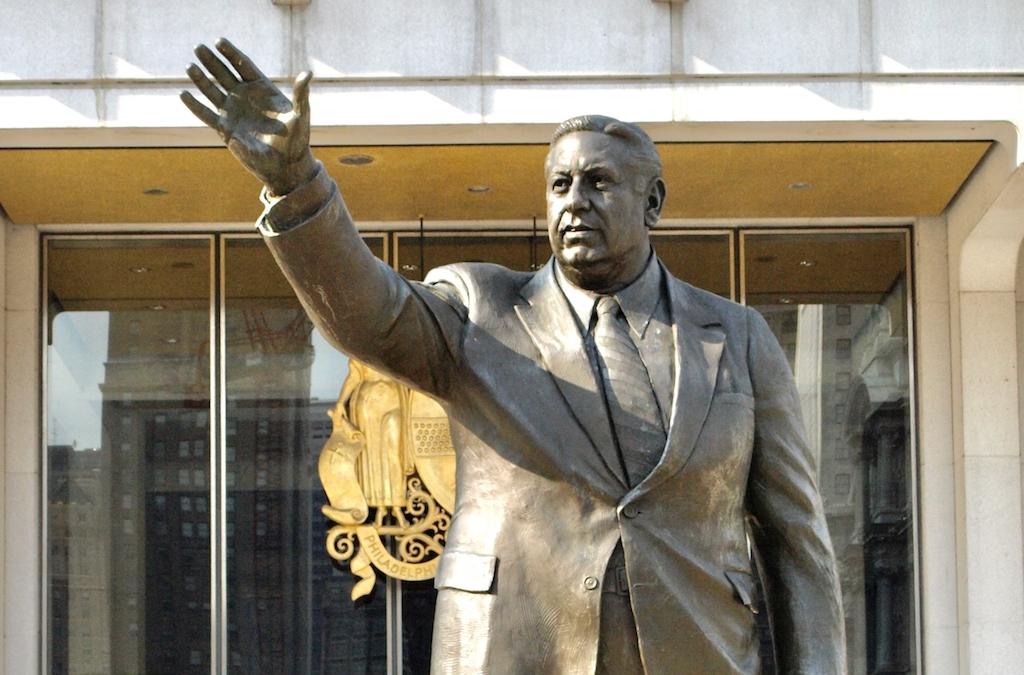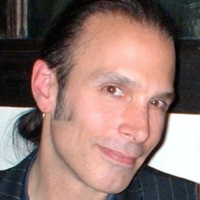In a city where statues go up (Octavius V. Catto) and statues come down (Christopher Columbus, his own Frank Rizzo), Glenside-based sculptor Zenos Frudakis is ahead of the game at a time when all of America is re-considering whom it pays tribute in terms of its public monuments, and whom it topples.
Whether you realize it or not, you see the work of the 69-year-old sculptor on a daily basis, and sense, perhaps, the meaning and vibration he’s lent to molding Giudicci clay and forging bronze into shape and form. You become part of (or rail against, if you so choose) his message or spirit; you commune with each piece’s physical heft, its socio-cultural weight or its politicized torpor.
“Or maybe you’ve just driven by, pulled out of your car, and taken selfies,” said the sculptor, warmly, from his Glenside studio.
Zenos’ universally beloved, gracefully expressive “Freedom” sculpture at 16th and Vine – a life-sized-plus, bronze behemoth at 20 feet long, eight feet high and weighing in at 7,000 pounds – touches on all manner of release: Freedom from internal struggle, adversarial circumstance from political, religious, sexual and racial persecution, to simply wanting to break free from the grips of COVID-19.
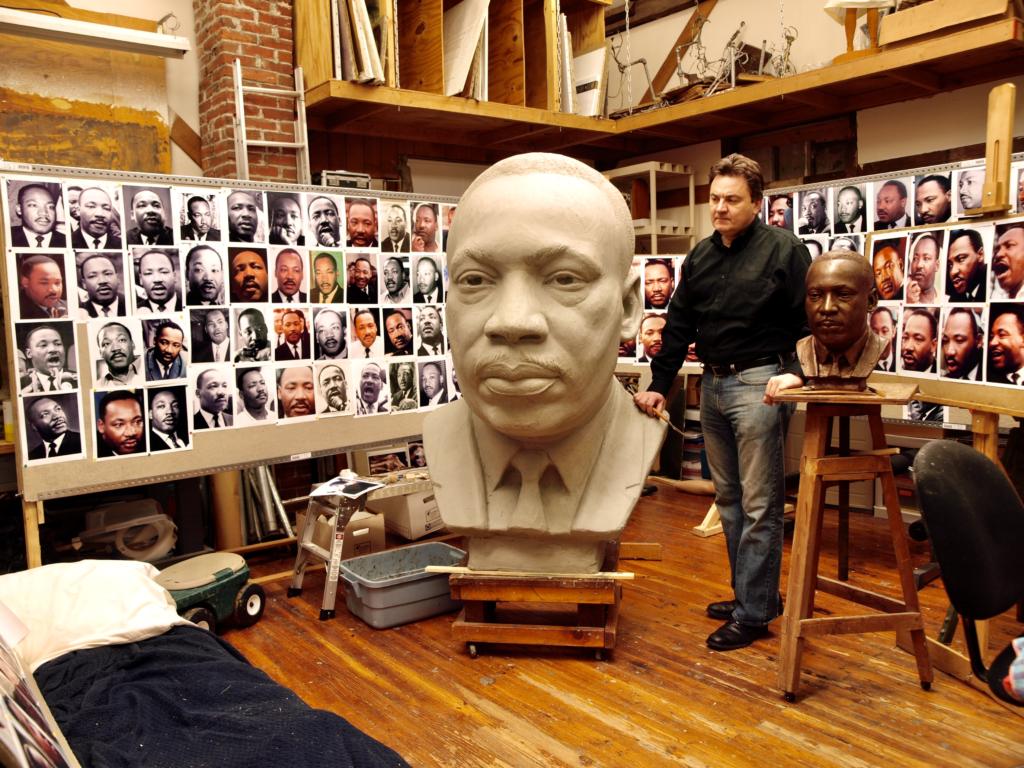
Frudakis’ “Knowledge is Power” at Rowan University in Glassboro, N.J., is dedicated to the often-forgotten ideals of intellectual history and presents the sculptor’s heroes, such as Darwin as Einstein, spouting their most famous quotes about literature, music and mathematical formulae. The sheer density of Frudakis’ “Reverend Dr. Martin Luther King, Jr.” bust, installed in MLK Memorial Park in Chester, speaks volumes to the freedom fighter-peacemaker’s teachings.
“This is poetry without words, a documentary in bronze,” said Frudakis.
A 16-foot-high, abstract bronze “Paradigm Shift” at Fort Washington’s GMAC Corporate Center stoically seeks answers to man’s spiritual, existential dilemmas. An over-life-sized “Nina Simone,” the pianist and activist who lived on Walnut Street, quarreled with Curtis Institute, and gigged in Atlantic City, stands lifelike and proud in Tyron, North Carolina’s Nina Simone Plaza. Even pitcher Steve Cartlon, third baseman Mike Schmidt, catcher Richie Ashburn and other Phillies’ B-ball Hall of Famers seem regal standing before Citizens Bank Park, greeting its crowds of hot dog-noshing, beer-guzzling fans. And though now disappeared from view, plucked from sight during the dead of night – right or wrong, Right or Left – Frudakis’ 10-foot-tall “Frank Rizzo” at the Municipal Services Building Plaza across from City Hall is, or was, a testament to one of this city’s most polarizing figures of civic pride (to some) and police brutality (to many more).
Art is my way of expressing philosophy, my first love – that and poetry.
– Zenos Frudakis
“Art is my way of expressing philosophy, my first love – that and poetry,” said Frudakis.
“It is an extension of my own journey, but it is not art therapy. There is an audience in mind. You try to be as personal as you can. The more personal, the more universal, as down deep, we all have the same feelings, fears and insecurities.”
That’s art at its most public. But, what is public art and sculpture to the man behind so many of its totems? What necessity must it all serve while inhabiting or breathing in the winds of social justice and equality, demanding that it must be reflective of a community, a city, its history and all of its inhabitants, fairly and equitably?
“As an artist, when you have such a reclusive relationship with your work, your animals are your best friends; your family; a consciousness,” said Frudakis before the start of a day’s worth of sculpting, of considering the bronze.
“Bing Clawsby is one cat. She talks a lot, even sings.”
Frudakis’ ex-wife and current business partner, Rosalie, named that cat, and continues to be a constant and necessary presence in the sculptor’s life and work.
“We have one grey male cat named Zane Grey and another, Mr. Grey, a British blue, watching over the studio. He’s like a lion.”
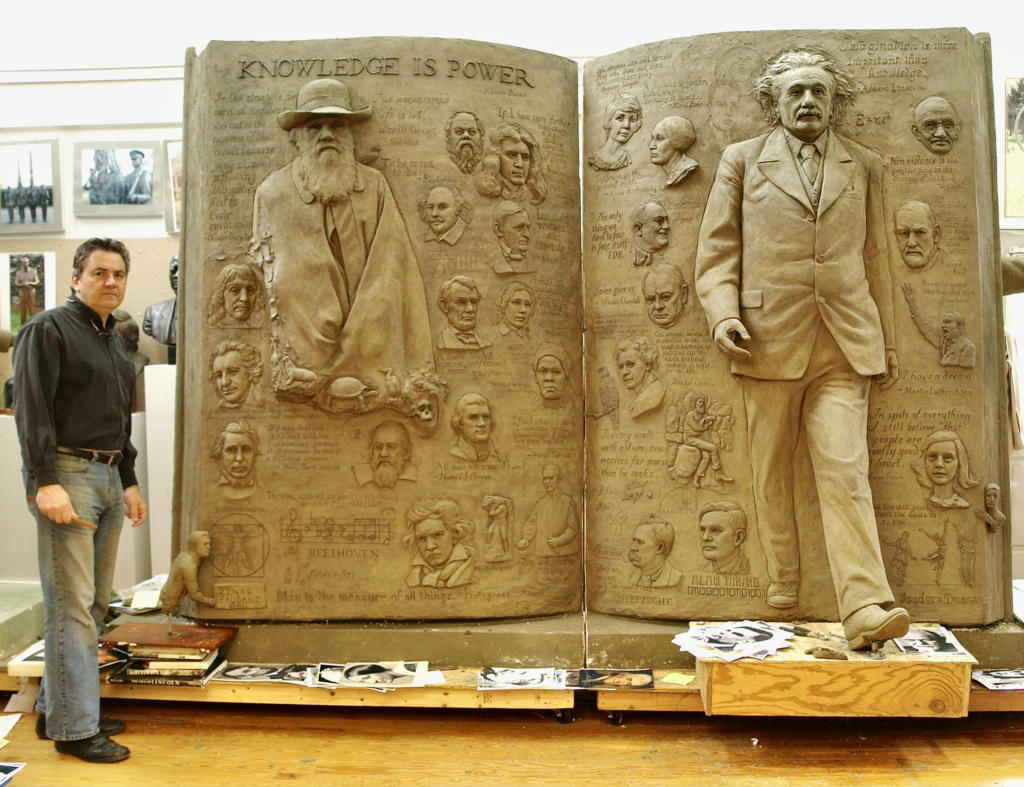
Frudakis has been in Glenside for 34 years, after having left his Center City studio – the one he inhabited In 1972 when he moved to Philadelphia from Gary, Indiana, and the work he had in its steel mills. At age 21, he earned degrees at the University of Pennsylvania and the Pennsylvania Academy of the Fine Arts, where he studied under his brother, EvAngelos, himself a public sculptor who carved in marble, and passed away in 2019.
“That was a really good school,” said Frudakis of PAFA.
“You could move from printmaking, to sculpting, to painting, from class to class, from model to model and study their musculature. You had nude models and life classes at all hours. And, often, your teachers were working artists. You could mentor yourself.”
Kant. Schopenhauer. Hemingway. Jung. Wolfe. Roethke. Don McLean. The man who built the Lincoln Monument. James Earl Frasier’s “Hidden Betrayal.” An elusive, bad-businessman-turned-poet-turned-Cretan-lira-playing father: All of these additional mentors litter our conversation, as well as the proud sculptor’s politics, life and work. For example, Frudakis not only used Nina Simone’s burial ashes as part of the welding for her statue (“in a bronze heart”), so to create a gravesite for the singer with his motive being mutability. He has some of the same clay that legendary sculptor Fraiser used for his work at the turn of the century for inclusion in Zenos’ new creations, conscious of spirit, and conscious of knowledge passed down, both now made into fresh physical form.
“It’s a personal smorgasbord of influence and inspiration,” said the sculptor.
“But unlike McLean (a friend of Frudakis), who just writes songs out of his head – without commission, without someone telling him what to do – public sculpture isn’t just something you can do, and put somewhere. Well, you can, and I have, but it can cost hundreds and thousands of dollars to put a big bronze up in a public space…Like Rodin’s ‘Gates of Hell,’ even though you are telling a particular story, there is a broadness to public art. People can enter that world. They can put themselves – project themselves – into that story. There is an open poetry to it all.”
You’re promoting an idea, someone else’s. You’re promoting an idea, making them into a hero.
– Zenos Frudakis
How did those gates open? Why do, or why start, in public art to begin with? How did Frudakis get into the business of mass-appreciated monuments?
“Part of that came from wanting to influence opinion. Part of it came from wanting to bring people and ideas back to life, something that supersedes and lives long after them. Public sculpture is not easy to get into – very few artists even get to do one, let alone hundreds. When you get out of art school, there’s really hardly any work to be found…So I began selling my brother’s work and making contacts with businesses and clients. I talked him into letting me and Rosie promote his work and sell it. He was in his 50s when I was getting out of school, so selling his work made sense.”
The young Frudakis got his earliest financial commission for his brother, EvAngelos, who created the Colonial figure of “The Signer,” a nine-and-a-half foot tall statue that resides in Signer’s Park before the Gilbert Stuart House near Independence Hall. Physically working on “The Signer” with his brother, as well as making the sale, gave Zenos a taste for both ends of the public sculpture biz.
“As I built my portfolio, I knew I could get into public work,” said Frudakis.
Zenos got his first real chance when corporate executives behind Strawbridge & Clothier wanted a large animal sculpture for their Burlington Center Mall in New Jersey.
“Stockton Strawbridge personally asked me to come up with something for a fountain they were building. So I drew many possibilities, and came up with an elephant. I didn’t want to create a taxidermy elephant, because it is poetry in a way you are creating. It is art. It wasn’t a particular elephant, it was an abstracted, idealized essential elephant.”
A life-sized elephant then became Frudakis’ first public sculptural project, an accomplishment he compares to landscape architect Frederick Law Olmsted’s first job being Central Park or Bobby Kennedy’s first law job being Attorney General.
Poetry or not, the politics of public art wasn’t always pretty. For all of the commissions he’s won and executed – hundreds of mass-viewed monuments around the world, including a Mark Twain bust at NYC’s Lotos Club, a statue of famed landscape architect Frederick Law Olmstead for the North Carolina Arboretum, and tall bronze totems at Japan’s Utsukushi-ga-hara Open Air Museum – Frudakis, a quiet man, isn’t up for the cocktail parties and politics of the monuments biz. Secondly, not being able to “do your own thing” is an often-wearying task for an artist with an aesthetic and intellectual agenda all his own.
“At 69, I can’t help but think I might slow down my public work, slightly, to concentrate more on my own sculpting and painting.”
Discussing one of the most famed classics of public art, the Sistine Chapel, Frudakis recalled its maker, Michaelangelo, tearing up the original plans of the Vatican’s to do things his way.
“He made his own vision. He knew his own journey. He knew something you don’t know – cutting through a dense forest with a machete that people haven’t been through yet. He forged a path. As an artist, I’m forging a path, dealing with businessmen and civic leaders who have an idea for something. Which is good. But, how can they be as expert at my business as I am?”
When I remind Frudakis that for every Michaelangelo, there was a Pope Julius II pursuing his own vision, he laughed.
“Art is often made to be propaganda, and not always in the worst sense,” he said.
“You’re promoting an idea, someone else’s. You’re promoting an idea, making them into a hero.”
Looking at the controversies revolving around the torn-down generals and majors of the Southern Confederacy, Frudakis makes it very clear: These are not heroes. And this is not history.
“Calling that ‘history’ is a lame argument. That part of history that they represent is not a very good history. Promoting Jim Crow – promoting superiority of the Confederate cause, of white over Black. The real history is Confederate General Forrest who murdered African-American Union soldiers that he captured. It’s an ugly history, not one promoted by those who wish to keep those statues up, and celebrated. The same one that doesn’t tell the truth about Robert E. Lee. He wasn’t a nice guy or a gentleman general. He was a lousy general who let more of his men die then needed to serve his own ego and got beat by Ulysses S. Grant. Lee was a horrible man who, when a slave of his tried to escape, and was recaptured, he was whipped with leather tethers tipped with broken glass so they tore the flesh deeper, then put salts on the wounds.
“There was nothing redeeming about Forrest and Lee, but the South, largely through its sculpture – its public monuments – made their own narrative; that these men were great mannered gentlemen and masters of warfare.”
Redeeming quality is a big part of what Frudakis sees, in the world of cancel culture, between tearing down a public monument and leaving one up, but with proper context.
Moving from his first public sculpture of an elephant for Strawbridges into his first historic figure, Frank Rizzo, is a best example for its sculptor.
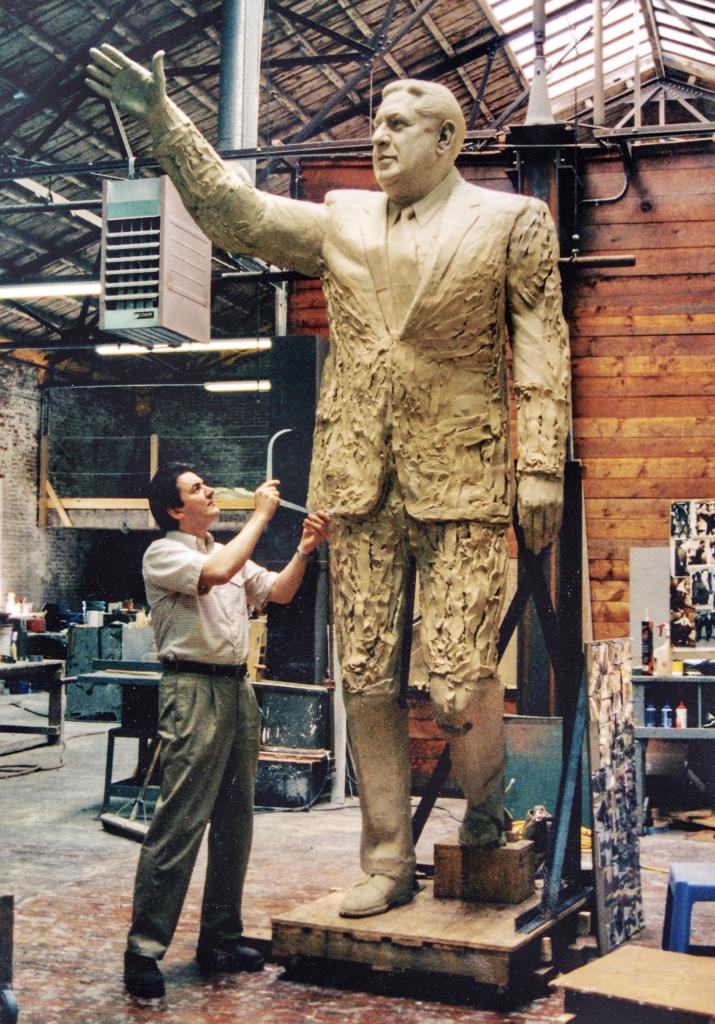
After the controversial, nightstick wielding police commissioner and two-term mayor passed away in 1991, an elite group of Philadelphians close to Rizzo (his personal secretary, retired policemen, etc.) set up fundraising, location hunting and artist-finding. Frudakis moved quickly to the front of the line as he had, around that same time, crafted busts of City Council presidents and Mayor Wilson Goode, as well as painted portraits of Philadelphia civil rights activist Samuel Evans and K. Leroy Irvis, the leader of the Pennsylvania House of Representatives, and the first African American to serve as a speaker of the House in any state legislature in the U.S. since Reconstruction.
“It was not easy to get jobs for large-scale historical sculptural figures back then, especially in such a prominent place as downtown Philadelphia, out in the open,” said Frudakis with awe.
“I needed to get a commission of a man in a suit. I know that sounds funny, but most of the public sculpture commissions are men in suits – old, white men in suits. They’re the ones with the money. You have to do the commissions that pay money – the CEOs, the head of Glaxo, golf professionals – to do those others that don’t pay as well.”
Wanting, presumably, to see themselves reflected in each monument, these old, white CEOs and top-tier politicos chose an impressionable, talented sculptor eager to land his first, epic outdoor monument – in a suit – in the Cradle of Liberty.
“It was a private commission,” he said of Rizzo.
“I didn’t have to go through the city or the usual cocktail party, playing favorites politics to get it.”
I had suggested that the ‘Rizzo’ should remain in place, as an educational piece, with other statues next to it, whether I made them or not, talk about the history of that moment; something multifaceted, the physics of complementarity. Different views from different angles.
– Zenos Frudakis
Frudakis said he wanted to do something with the statue that had never been done before: Movement. He said he wanted Rizzo walking down steps and waving to a crowd.
Frudakis was a young student in 1972 when Rizzo, first, was mayor, and knew the rumors and the news reports of anti-Black and anti-gay sentiment and action. Going back to Frudakis’ comment regarding some history being bad history, the sculptor – in consideration of the Rizzo’s statue’s recent removal – has made a plea for a more complete history, a fuller, rounded story showing all sides of the picture.
“I had suggested that the ‘Rizzo’ should remain in place, as an educational piece, with other statues next to it, whether I made them or not, talk about the history of that moment; something multifaceted, the physics of complementarity. Different views from different angles,” he said.
One of the additional statues Frudakis suggested was that of the Reverend Leon L. Sullivan, the anti-apartheid activist and the man behind the Philadelphia OIC with the motto: “Helping people help themselves.”
Taking on a subject such as Rizzo, with whom he didn’t agree, or adhere to his strong-arm tactics, Frudakis compared it to a defense attorney taking on a disreputable client.
“This was a different time. You wanted to learn. You wanted to stay afloat. You wanted and needed to stay in the business, then. Now, I didn’t think that the ‘Rizzo’ statue should necessarily be equated with, say, the Confederate general statues that came down. I told this to [Philly Councilperson] Helen Gym. The Confederate general statues had to come down. They were traitors responsible for the unnecessary deaths of many men. Rizzo should not be in the same category. You’re actually taking away from the gravity of the horrors wreaked by the Confederate generals – truly evil men like Stonewall Jackson – by including Rizzo in that group of statues that must come down. Rizzo didn’t just do bad things…
“George Washington and Thomas Jefferson were slave owners, but, unlike other slave owners who did nothing great at all in their lifetimes, Washington and Jefferson created this country, and were great in other ways…We have to be careful about whose and what statues we take down.”
In the end, Frudakis believed that the “Rizzo” had to come down for one great reason: A danger to our health and well-being.
“First off, people were trying to burn it, which was silly. You could never get up enough heat to do any damage. Secondly, people were trying to pull it down without realizing that his statue was not on solid ground, that it was on top of the subway,” said the sculptor.
“If people had managed to pull it down, it would have killed someone. Outrage and upset, yes, but pulling it down was scary.”
Having a commission such as “Frank Rizzo,” unveiled on Jan. 1, 1999, made it possible for Frudakis to execute the 100-plus others that he’s created around the globe, as well as in his hometown. Having Frudakis’ “Freedom” come one year after the Rizzo statue was no accident.
“I couldn’t have done the latter without the former.”
His “Freedom” of the year 2000 came simply from a desire to free himself from a situation he no longer wished to be in. From there, he extended that sensation and opened up its feel and, literally, extended its arms and legs to fresh possibility.
“I believed in this sculpture, philosophically, and understanding the underdog has given my work empathy. It has given my work a chiaroscuro – a light and a dark. You can’t have the light without the dark…I wanted people to be able to put themselves in it – to do some good in the world.”
Frudakis’ “MLK,” as well as his “Frederick Douglass” and “Harriet Tubman” busts, stem as much the sculptor from having made a name for himself with the “Rizzo,” as it does his progressive political nature. The same is true of his massive bronze “Knowledge is Power” statue at Rowan U, one reflecting “the power of powerful ideas, of Socrates, of Darwin, of Harriet Tubman’s.”
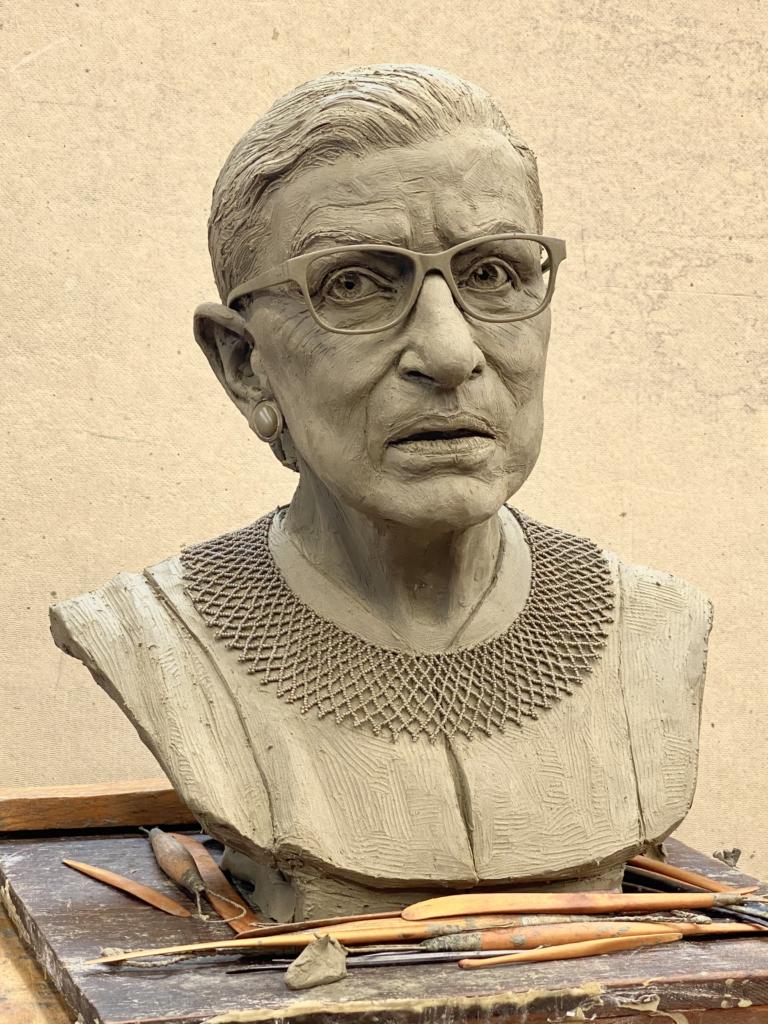
Moving into the present, along with creating a bronze statue of Thomas Paine for a potential Philadelphia client, there is the sculptor’s still-work-in-progress bust, “RBG,” which captures the handsome likeness and spirit of tenacity that is the late Supreme Court Justice Ruth Bader Ginsberg. Originally sculpted for Frudakis himself, the “RBG” bronze is going into the foyer of the Freedom for Religion Foundation in Wisconsin.
Save for statues of golfers, baseball players and elephants, Frudakis’ public work is proudly societal, political, and humanist, as well as ethical. Even if opinions change, or must change, his statues will always act as visual documentaries capturing as much of a subject’s soul as possible – without being a complete picture; something Frudakis would like to see changed, say, with additional signage and accompanying works of bronze and clays.
And, if there’s one thing of which Frudakis is certain for himself, it’s that sculpture – and not the spoken word – is his true forte.
“Next time we talk, I should be creating my answers in clay. They would say more. My work is who I am. I hold nothing back in my sculpture.”
